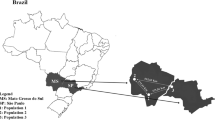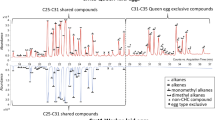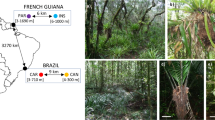Abstract
Although cuticular hydrocarbons (CHCs) have received much attention from biologists because of their important role in insect communication, few studies have addressed the chemical ecology of clonal species of eusocial insects. In this study we investigated whether and how differences in CHCs relate to the genetics and reproductive dynamics of the parthenogenetic ant Cerapachys biroi. We collected individuals of different ages and subcastes from several colonies belonging to four clonal lineages, and analyzed their cuticular chemical signature. CHCs varied according to colonies and clonal lineages in two independent data sets, and correlations were found between genetic and chemical distances between colonies. This supports the results of previous research showing that C. biroi workers discriminate between nestmates and non-nestmates, especially when they belong to different clonal lineages. In C. biroi, the production of individuals of a morphological subcaste specialized in reproduction is inversely proportional to colony-level fertility. As chemical signatures usually correlate with fertility and reproductive activity in social Hymenoptera, we asked whether CHCs could function as fertility-signaling primer pheromones determining larval subcaste fate in C. biroi. Interestingly, and contrary to findings for several other ant species, fertility and reproductive activity showed no correlation with chemical signatures, suggesting the absence of fertility related CHCs. This implies that other cues are responsible for subcaste differentiation in this species.


Similar content being viewed by others
References
Blight O, Berville L, Vogel V, Hefetz A, Renucci M, Orgeas J, Provost E, Keller L (2012) Variation in the level of aggression, chemical and genetic distance among three supercolonies of the Argentine ant in Europe. Mol Ecol 21:4106–21
Breed MD, Perry S, Bjostad LB (2004) Testing the blank slate hypothesis: why honey bee colonies accept young bees. Ins Soc 51:12–16
Brian MV (1973) Caste control through worker attack in the ant Myrmica. Ins Soc 20:87–102
Denis D, Blatrix R, Fresneau D (2006) How an ant manages to display individual and colonial signals by using the same channel. J Chem Ecol 32:1647–61
Drescher J, Blüthgen N, Schmitt T, Bühler J, Feldhaar H (2010) Societies drifting apart? Behavioural, genetic and chemical differentiation between supercolonies in the yellow crazy ant Anoplolepis gracilipes. PLoS One 5:e13581
Clarke KR, Gorley RN (2006) PRIMER v6: User Manual/Tutorial. PRIMER-E, Plymouth
Cuvillier-Hot V, Lenoir A, Peeters C (2004) Reproductive monopoly enforced by sterile police workers in a queenless ant. Behav Ecol 15:970–975
Emlen DJ (1994) Environmental control of horn length dimorphism in the beetle Onthophagus acuminatus (Coleoptera: Scarabaeidae). Proc R Soc Lond B 256:131–136
Gibbs AG, Crockett EL (1998) The biology of lipids: integrative and comparative perspectives. American Zoologist 38:265–267
Gibbs AG (2002) Lipid melting and cuticular permeability: new insights into an old problem. J Ins Physiol 48:391–400
Giraud T, Pedersen JS, Keller L (2002) Evolution of supercolonies: the Argentine ants of southern Europe. Proc Natl Acad Sci U S A 99:6075–9
Hartmann A, D'Ettorre P, Jones GR, Heinze J (2005) Fertility signaling-the proximate mechanism of worker policing in a clonal ant. Naturwissenschaften 92:282–286
Hartmann A, Wantia J, Torres JA, Heinze J (2003) Worker policing without genetic conflicts in a clonal ant. Proc Natl Acad Sci USA 100:12836–12840
Heinze J, Stengl B, Sledge MF (2002) Worker rank, reproductive status and cuticular hydrocarbon signature in the ant, Pachycondyla cf. inversa. Behav Ecol Sociobiol 52:59–65
Hölldobler B, Wilson EO (1990) The Ants. Harvard University Press, Cambridge
Holman L, Jørgensen CG, Nielsen J, D'Ettorre P (2010) Identification of an ant queen pheromone regulating worker sterility. Proc R Soc Lond B 277:3793–800
Howard RW, Blomquist GJ (2005) Ecological, behavioral, and biochemical aspects of insect hydrocarbons. Annu Rev Entomol 50:371–393
Hunt J, Simmons LW (1997) Patterns of fluctuating asymmetry in beetle horns: an experimental examination of the honest signalling hypothesis. Behav Ecol Sociobiol 41:109–114
Ichinose K, Lenoir A (2009) Ontogeny of hydrocarbon profiles in the ant Aphaenogaster senilis and effects of social isolation. CR Biologies 332:697–703
Kronauer DJC, Pierce NE, Keller L (2012) Asexual reproduction in introduced and native populations of the ant Cerapachys biroi. Mol Ecol 21:5221–5235
Kronauer DJC, Tsuji K, Pierce NE, Keller L (2013) Non-nest mate discrimination and clonal colony structure in the parthenogenetic ant Cerapachys biroi. Behav Ecol 24:617–622
Le Conte Y, Hefetz A (2008) Primer pheromones in social Hymenoptera. Annu Rev Entomol 53:523–542
Lecoutey E, Chaline N, Jaisson P (2011) Clonal ant societies exhibit fertility-dependent shifts in caste ratios. Behav Ecol 22:108–113
Liebig J, Peeters C, Oldham NJ, Markstadter C, Hölldobler B (2000) Are variations in cuticular hydrocarbons of queens and workers a reliable signal of fertility in the ant Harpegnathos saltator? Proc Natl Acad Sci USA 97:4124–4131
Mantel N (1967) The detection of disease clustering and a generalized regression approach. Cancer Research 27:209–220
Martin SJ, Weihao Z, Drijfhout FP (2009) Long-term stability of species-specific cuticular hydrocarbon profiles in hornets. Biol J Linnean Soc 96:732–737
Meirmans PG, Tienderen PH (2004) Genotype and Genodive: two programs for the analysis of genetic diversity of asexual organisms. Mol Ecol Notes 4:792–794
Moczek AP, Emlen D (2000) Male horn dimorphisms in the scarab beetle, Onthophagus taurus: do alternative reproductive tactics favour alternative phenotypes. Anim Behav 59:459–466
Monnin T, Malosse C, Peeters C (1998) Solid Phase MicroExtraction and cuticular hydrocarbon differences related to reproductive activity in the queenless ant Dinoponera quadriceps. J Chem Ecol 24:473–490
Monnin T, Peeters C (1999) Dominance hierarchy and reproductive conflicts among subordinates in a monogynous queenless ant. Behav Ecology 10:323–332
Monnin T (2006) Chemical recognition of reproductive status in social insects. Ann Zool Fenn 43:515–530
Oxley P, Ji L, Fetter-Pruneda I, McKenzie S, Li C, Hu H, Zhang J, Kronauer DJC (2014) The Genome of the Clonal Raider Ant Cerapachys biroi. Curr Biol 24:1–8
Peeters C, Monnin T, Malosse C (1999) Cuticular hydrocarbons correlated with reproductive status in a queenless ant. Proc R Soc Lond B 266:1323–1327
Pennick CA, Liebig J (2012) Regulation of queen development through worker aggression in a predatory ant. Behav Ecol 23:992–998
Queller DC, Goodnight KF (1989) Estimating relatedness using genetic markers. Evolution 43:258–275
Ravary F, Jaisson P (2004) Absence of individual sterility in thelytokous colonies of the ant Cerapachys biroi Forel (Formicidae, Cerapachyinae). Ins Soc 51:67–73
Ravary F, Jahyny B, Jaisson P (2006) Brood stimulation controls the phasic reproductive cycle of the parthenogenetic ant Cerapachys biroi. Ins Soc 53:20–26
Ravary F, Jaisson P (2002) The reproductive cycle of thelytokous colonies of Cerapachys biroi Forel (Formicidae, Cerapachyinae). Ins Soc 49:114–119
Slessor KN, Winston ML, Le Conte Y (2005) Pheromone communication in the honeybee (Apis mellifera L.). J Chem Ecol 31:2731–45
Smith AA, Hölldobler B, Liebig J (2008) Hydrocarbon signals explain the pattern of worker and egg policing in the ant Aphaenogaster cockerelli. J Chem Ecol 34:1275–1282
Teseo S, Kronauer DJC, Jaisson P, Châline N (2013) Enforcement of reproductive synchrony via policing in a clonal ant. Curr Biol 23:328–332
Teseo S, Châline N, Jaisson P, Kronauer DJC (2014) Epistasis between adults and larvae underlies caste fate and fitness in a clonal ant. Nat Commun 5:3363
Tsuji K, Yamauchi K (1995) Production of females by parthenogenesis in the ant Cerapachys biroi. Ins Soc 42:333–336
Tsutsui ND, Suarez AV (2003) The colony structure and population biology of invasive ants. Conserv Biol 17:48–58
Wetterer JK, Kronauer DJC, Borowiec ML (2012) Worldwide spread of Cerapachys biroi (Hymenoptera: Formicidae: Cerapachyinae). Myrmecological News 17:1–4
Wheeler DE (1986) Developmental and physiological determinants of caste in social Hymenoptera: evolutionary implications. Amer Nat 128:13–34
Wheeler DE (1991) The developmental basis of worker caste polymorphism in ants. Amer Nat 138:1218–1238
Acknowledgments
We thank Paul Devienne and Marjorie Labédan for technical support with ant colonies at LEEC, and Chloé Leroy for technical assistance with gas chromatography–mass spectrometry. This work was supported by a Ph.D. research grant from the French Ministry of Research to S.T., as well as a Junior Fellowship from the Harvard Society of Fellows and a Milton Fund Award to D.J.C.K. All coauthors have agreed on the contents of the manuscript.
Author information
Authors and Affiliations
Corresponding author
Rights and permissions
About this article
Cite this article
Teseo, S., Lecoutey, E., Kronauer, D.J.C. et al. Genetic Distance and Age Affect the Cuticular Chemical Profiles of the Clonal Ant Cerapachys biroi . J Chem Ecol 40, 429–438 (2014). https://doi.org/10.1007/s10886-014-0428-y
Received:
Revised:
Accepted:
Published:
Issue Date:
DOI: https://doi.org/10.1007/s10886-014-0428-y




